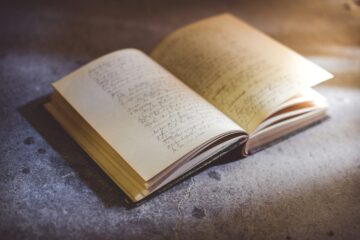English Non-Fiction and Its Classification

Fiction that is not unrealistic and imaginative is called Non-fiction. This form of fiction is important for understanding a country’s reality and socio-political structure.
In this article, we will discuss major non-fiction. So, please stay connected with us to explore English Literature in a new way.
Major Non-Fictions are
1. The Essay
2. The Biography
3. The Autobiography
4. The Memoirs
5. The Periodical Journal
6. Diaries
7. Long Prose
1. The Essay
- Short non-fiction prose works that generally deal with a single topic.
- It also explores multiple themes as well.
- It is a flexible form of writing.
Two forms of ESSAY
a. Formal Essay:
- Relatively impersonal and instructive.
- Highly knowledgeable and addressed to a thoughtful audience.
b. Informal Essay:
- This is relatively personal. It deals with personal or everyday things rather than with public affairs on specialized topics.
- This essay form is relaxing and self-revelatory.
History
- The French writer Montaigne first coined the word ‘essai’ in 1580, using it as the title for his first publication.
- The Greek Theophrastus and Plutarch and the Roman Cicero and Seneca wrote Essays long before Montaigne.
- Montaigne’s Essays were written in an Informal manner while Bacon’s Essays(1597) were all formal, didactic and impersonal. Bacon uses a minimum number of words to express his ideas.
- During that time Sir William Cornwallis’ Essays were personal reflections much in the tradition of Montaigne.
- His style was later explored in the works of Abraham Cowley.
- The next major English writers of this genre were Sir William Temple and Dryden.
- In the 19th century, Johnson made significant contributions to the genre with ‘The Rambler’ and ‘The Idler’.
- After that Goldsmith then Charles Lamb’s ‘Essays of Elia‘ offer delightful and very touching glimpses of the author.
Famous Essayists
In the 19th century:
Hazlitt, Thomas De Quincey, Coleridge, Macaulay, Carlyle, Ruskin, Arnold, Peter etc.
In the 20th century:
Max Beerbohm’s ‘And Even Now'(1920),
Virginia Woolf’s “The Common Reader”(1925), “A Room of One’s Own”(1929).
Lytton Starchy, Arthur Symons, E M Forster, D H Lawrence and Aldous Huxley
American Essayists
Washington Irving, Emerson, Thoreau, James Russell Lowell, Mark Twain.
2. Biography
- A piece of writing of a person’s life that not only depicts the various events of his or her life but also helps others to be inspired and live a successful life.
- The individuals who succeed in any field—whether business, writing, poetry, or spirituality—are highlighted in biographical content.
- It has ancient origins and has undergone many modifications; its focus has changed over the ages, yet it remains a popular literary form today.
- In modern times, Biography is sometimes in cinematic form as in Mark Zuckerberg’s Biography on ‘Social Media’, Mahindra Singh Dhoni in M.S. Dhoni: The Untold Story.
Late in the 17th century, John Dryden defined Biography neatly as ‘the history of particular men’s lives.
History
- Both the Ancient Greeks and Romans produced short, formal lives of Individuals.
- The most famed surviving example is
The Parallel Lives by Greek and Roman notables by the Greek writer Plutarch, the source of Shakespeare’s plays and Roman subjects. - In the Medieval Period, the authors focused more on Hagiography(the stylized lives of Christian saints) than on true Biography.
- Bede’s writing on St. Cuthbert and Eadmer’s biography of St. Anselm are excellent examples of Middle English Biographies.
- In England, the 18th century is the emergence of full-scale Biography. During this time the theory of Biography became a special literary genre.
- Samuel Johnson’s ‘Lives of the English Poets’, and James Boswell’s ‘Life of Samuel Johnson’(1791) are two of the best known of all English Biographies.
- In Modern times, the Biographies of notable women and men have become one of the most popular literary forms.
3. The Autobiography
- An autobiography is a different form of Biography.
- There is only one distinction between Biography and Autobiography
- A biography is a written account of a person’s life by others, but an Autobiography is a biography in which the authors write about themselves.
- We get more clear and straightforward accounts in the Autobiography.
- As the author writes about themselves, it can easily grab our attention with its honest and natural way of speaking and lifestyle.
- We find the Autobiographies written by notable authors and all the people are noteworthy. So reading about their lives and struggles helps us live our lives beautifully and shows how to tackle the situation and hindrances.
- We can learn many lessons from their experiences that leave us making fewer mistakes in the way of great achievements.
History
- Robert Southey first used the term in 1809.
- The first real autobiography was probably St. Augustine’s Confessions(4th century).
- Apart from sections of Bede’s Ecclesiastical History, little of the Autobiography is to be found before the 15th century.
- It was only in the 16th century that Autobiography became common.
- The practice of keeping diaries became popular from the early 17th century and a greater number of autobiographies came to be written since the 17th century.
- Since the 19th century, almost all kinds of Autobiographies have flourished.
- Several excellent Autobiographical pieces were published during the First World War.
- Since 1950 there has been an excess of Autobiographical writings.
- Examples:
Thomas De Quincey’s ‘Opium Eater‘,
Wordsworth’s ‘Prelude‘ etc.
4. The Memoir
- A memoir is slightly different from a Biography or Autobiography.
- A Biography or Autobiography tells the story of life, while a memoir often tells the story of a particular event or time, such as a Touchstone(a metaphor refers to any physical or intellectual measure by which the validity or merit of a concept can be tested) moment a turning point from the author’s life.
- The Author of a Memoir may be referred to as a memoirist or memorialist.
6. The Diaries
- It is a form of autobiography, daily records of a Diarist’s activities and reflections.
- The diaries are written for personal use only. It contains the frankness of the writers which is unlike writing down for publication.
- Its ancient lineage is indicated by the existence of the term in Latin, diarium, itself derived from dies(‘days’)
History
- The DIARY form began to flower as a literary genre in the post-Renaissance.
- In the late Renaissance, the individuals stressed their lifestyle as the literature flourished in many folds.
- The Diarists’ diaries, in addition to their revelations, recorded social and political history, which helped to learn the social and political structure of that time.
Greatest Diarists in English Literature
- The two greatest Diarists are John Evelyn and Samuel Pepys.
- The Diary of Samuel Pepys was from January 1, 1660, to May 31, 1669.
- In his Diaries, he gives both an astonishing frank picture of his foible and follies and a stunning picture of life in London, at the court and the theatre, in his household, and his household, and in his Navy office.
7. The Long Prose
- The prose is a form of written or spoken language that usually exhibits a natural flow of speech and grammatical structure.
- It is not random text or an unorganized conversation. In Literature, prose is a written account that deals with certain topics and reflects some aspects of society.
- The term prose is derived from the Old French ‘prose‘, which originates in the Latin expression ‘prosa oratio‘(literally straightforward speech).
- In Prose, there is a plot, a character, a theme, a style and a story.
- Examples:
Thomas Malory’s ” Morte d’ Arthur”,
Wyclif’s “The Bible”,
Roger Ascham’s “The School Master”,
Thomas Carlyle’s “Sartor resartus”, “French Revolution.”
References
“Anthem Dictionary of Literary Terms and Theory” by Piyas Chakrabarti.”, A Glossary of Literary Terms” by M.H. Abrams and G.G. Harpham.” History of English Literature” by Edward Albert, “A History of English Literature” by Rabindranath Chakraborty. en.wikipedia.org.



0 Comments